Córdoba
and Medina Azahara
From
Úbeda we headed westward to Córdoba, where we spent the
next few nights. Along the way, we stopped at Baños de la Encina,
a sleepy village dominated by the huge Moorish fortress. After all,
this was the border between the Muslim south and the Christian north
for hundreds of years. Unfortunately, the fort was closed for renovations.






The
countryside around Baños de la Encina is really barren.
Córdoba
was once the capital of Moorish Spain, ruled from 756 to 1031 by a
caliph who was a descendant of Muhammad's family. Its old city still
has many of the buildings built by the caliphs set amidst narrow streets
of whitewashed houses.

We
told you they were narrow streets! (We had to drive our rented car down this
street
to park it, a feat Brian accomplished only by closing the sideview mirrors and
inching along
while having Joe and Matt navigate from outside in front of the two sides of
the car.


Large
sections of the Moorish town walls survive--and, on the left, a town gate.


As
elsewhere throughout the south, Muslim mosques were converted to Christian churches.
In most cases, the original buildings were demolished, but often--as in these
examples--
the minarets (towers from which Muslims are called to prayer) were converted
into church towers.

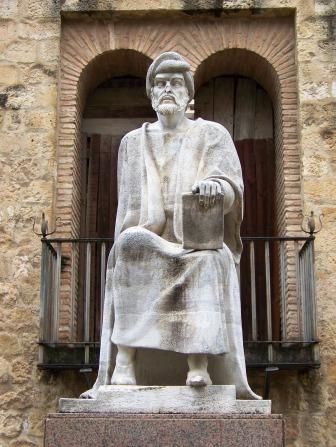
Córdoba
was renowned under its caliphs as a center of higher education. Among its best
known teachers were the
Muslim Abu Ali ibn Sina (known in Christian Europe as Avicenna) and the Jew
Moses ben Maimon (known as
Maimonides), both of whom taught philosophy, theology, and medicine. Modern
Córdoba commemorates
both with statues, Avicenna on the left and Maimonides on the right (from different
parts of the city).



After
the Christian conquest of Córdoba in 1236, a large medieval fortress
called the Alcázar
was built, which also served as the royal residence whenever the kings of Spain
visited the city.


Lots
of bits and pieces of the Moorish tradition survive in architecture, often--as
in these examples--mixed with
other styles. On the left, the typical horseshoe arch is surmounted by a Renaissance
portal. On the right,
the entryway and lower story window are Moorish while the upper story windows
are Gothic.
The
jewel of Córdoba is without question its former mosque, still called
the Great Mosque of Córdoba
even though it was converted into a Christian cathedral in the thirteenth century.


From
the exterior, the mosque appears as a huge square building. On some sides, little
decoration has survived.

On
the western side, however, most of the doorways retain their embellishments.


The
artistry of sculpture around these doorways is incredible. (In the Muslim religious
tradition, it is forbidden
to represent human figures or even living things, so Muslim artists have long
excelled at geometrical design.)
The
beauty of the exterior pales in comparison to the interior, where a forest of
columns--many of which were
Roman ones reused--is topped by two rows of arches, one atop the other. In a
typical feature of
this early Moorish architecture, the arches have alternating bands of painted
red and white stone.




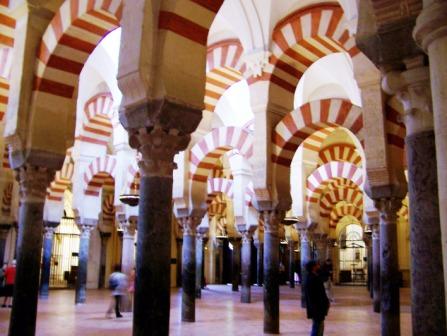

There
are more than 850 columns--and the effect is dazzling. This original part of
the mosque was built in the eighth century.
To
this original structure were added in the tenth century wings in even more elaborate
styles--
multifaceted domes and multipointed arches. The opulence of the effect is overwhelming.






While
much of the mosque has been preserved as it was first built, even after it became
a church,
sadly beginning in 1523 parts of it were redone in more "Christian"
styles.


In
some areas, the flat ceiling above the double rows of arches was transformed
with Gothic tracery.

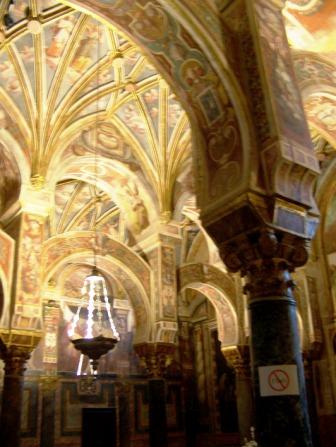
Other
areas were redone in Renaissance styles--with coffered ceilings, as on the left,
or painted frescoes, as on the right.

You
can see the effect best from a distance: its as if a Gothic cathedral were poking
out of the middle of the mosque.


Even
the minaret was transformed into a more traditional bell tower. On the right
is the entrance underneath the tower.

It
is still a spectacular monument--here, lit up at night.


Córdoba
is a vibrant modern city, too, with lots of attractive buildings from the late
nineteenth and early twentieth centuries.

We
happened to be there during Córdoba's annual fair
and saw lots of fairgoers in traditional Andalusian costume.
In
the tenth century, the greatest caliph of Córdoba, Abd al-Rahman III,
decided to leave his capital and, on a nearby hill, to build a palace for his
wife, Al-Zahra. Soon a town (called Medina al-Zahra by the Moors, and Medina
Alzahara in modern Spanish) sprang up around it. The place is now largely in
ruins, but is open to the public.


You
can see Córdoba in the distance from the ruins of Medina al-Zahra.



The
standing walls on even the collapsed buildings show off the horseshoe arches.
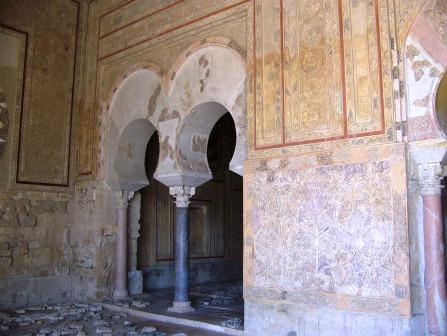
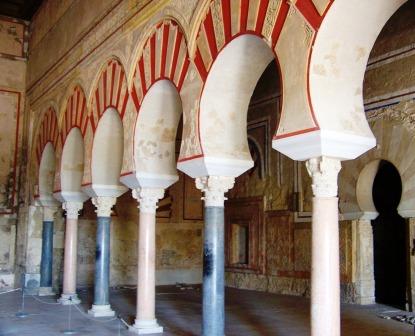
The
audience hall, where the caliph met his guests and visitors, has been partly
reconstructed.

Some
of the surviving details--such as the wall carvings--is stunning.

Elsewhere, the marble that once lined the walls and floors lies broken and scattered.
In
fact, the glory of Medina al-Zahra was shortlived. In 1010 (less than a hundred
years after it
was begun) it was sacked by Berber invaders from North Africa, and never again
inhabited.
Close
this page or click here to go to the next page.






















































